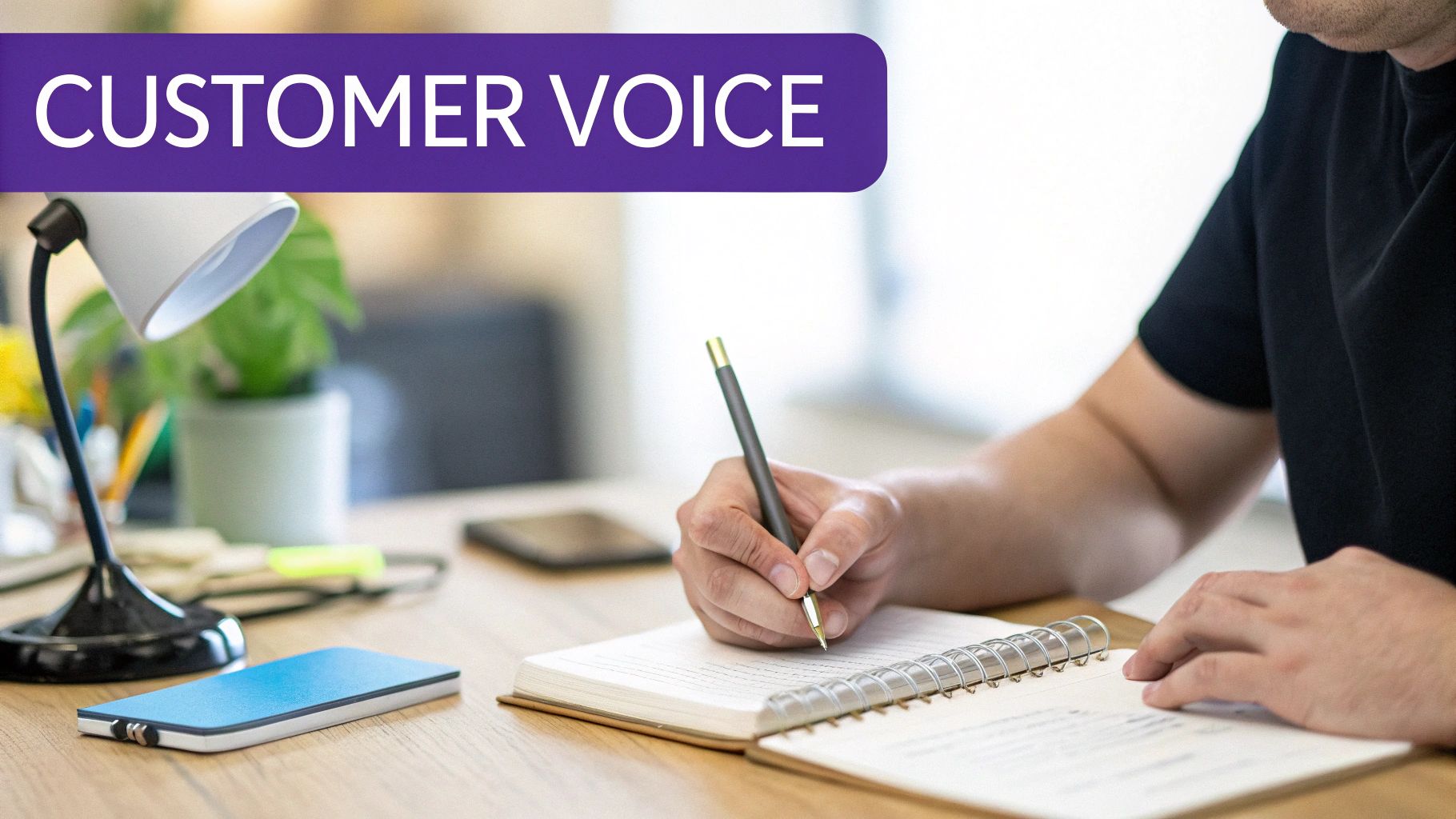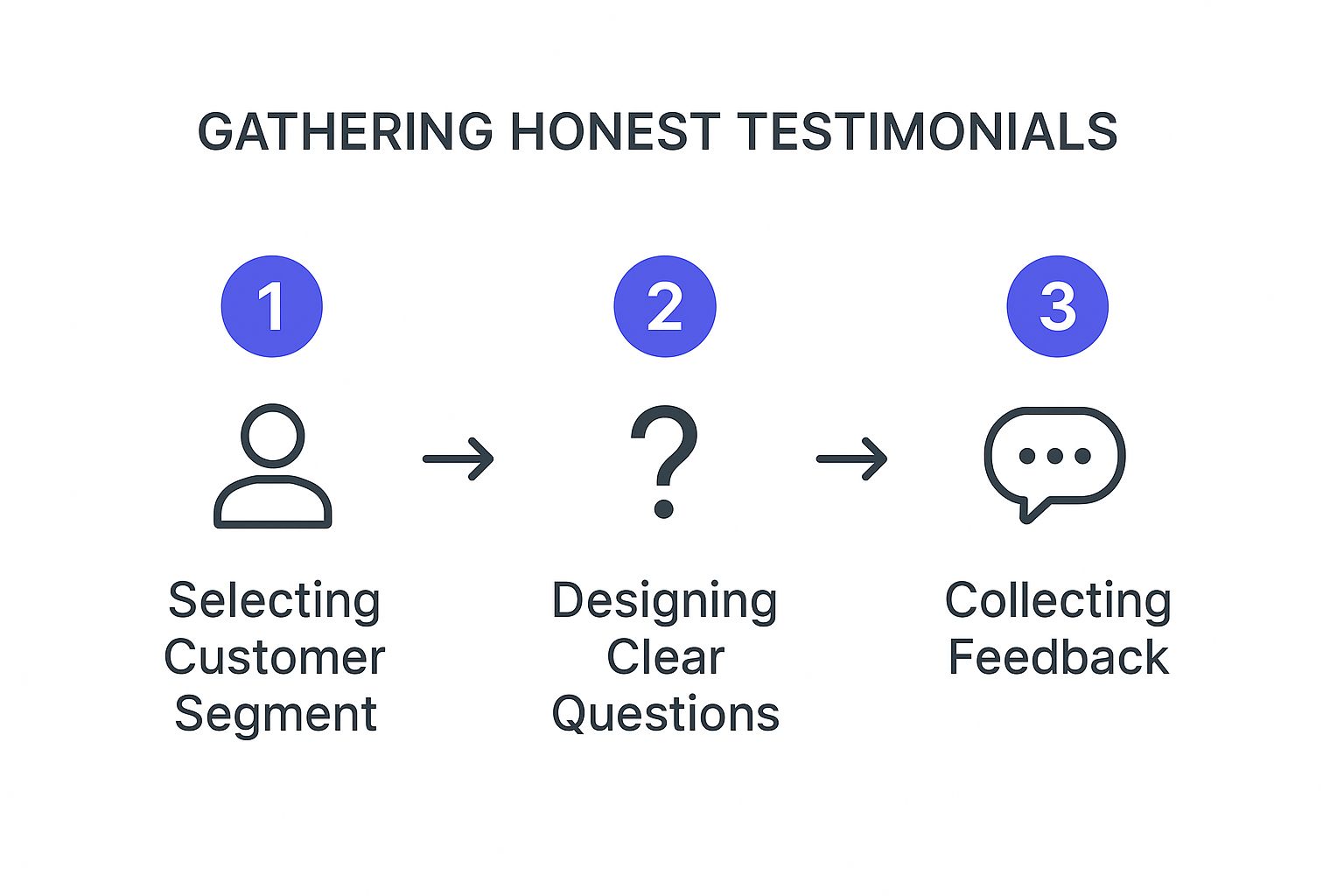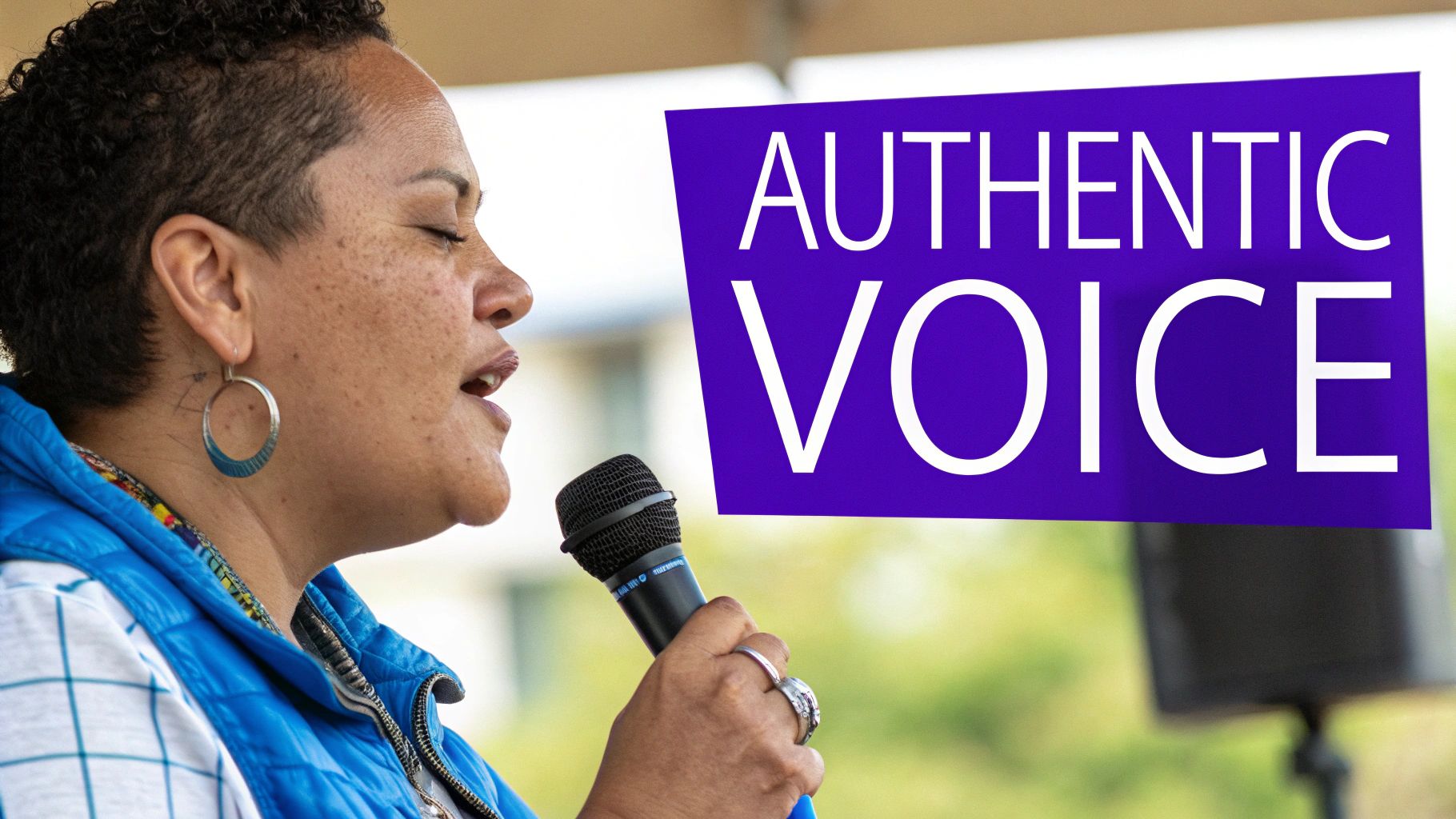How to Write a Testimonials That Convert | Proven Tips
Learn how to write a testimonials that build trust and boost sales. Discover expert strategies for crafting compelling customer stories today!
Posted by
Forget about slick ad campaigns for a minute. What really convinces someone to buy today? It’s trust. And nothing builds trust faster or more genuinely than a real customer sharing their story.
Learning how to write a testimonials isn't just another box to check on your content to-do list; it's a core part of building a brand people actually believe in.
Your Secret Sales Team Works 24/7

Think of authentic testimonials as your most effective, always-on sales team. They’re out there around the clock, building credibility and providing the social proof that today's savvy buyers need before they’ll even consider pulling out their wallet.
This isn’t just marketing fluff; it’s basic human psychology. When a potential customer sees that someone just like them has already used your product and gotten great results, it instantly lowers their guard and makes the purchase feel less risky.
This power is universal, no matter what you sell.
- For a SaaS company: A testimonial that says a specific feature "saved our team 10 hours a week" is infinitely more compelling than a dry feature list.
- For an e-commerce store: A review with a photo showing how a new armchair actually looks in a real person's living room provides context and builds confidence.
- For a service-based business: A detailed story about how your team went above and beyond during a support call can be the single thing that sets you apart from the competition.
How Testimonials Drive Decisions Across Industries
It's clear that reviews matter, but their impact varies. The table below shows just how much consumers in different sectors rely on them before making a decision.
| Industry | Consumer Reliance on Reviews | Key Takeaway |
|---|---|---|
| Retail & E-commerce | 95% | Nearly every online shopper looks for reviews. No reviews, no trust. |
| Hospitality & Travel | 93% | Travelers want assurance. A good review can book a room or a tour. |
| Local Services | 91% | From plumbers to hairstylists, local trust is built on community feedback. |
| Healthcare | 88% | Patients vet doctors and clinics online, seeking reassurance and quality care. |
| Financial Services | 85% | Choosing a bank or advisor is a big decision; peer experiences guide the way. |
The data is undeniable. No matter your industry, a significant portion of your potential customers are looking for social proof before they engage with you.
It’s a Two-Way Street
Great testimonials aren't just static quotes you slap on your homepage. They are a golden opportunity for a conversation that builds even more trust.
In fact, research shows that 89% of customers read business responses to online reviews, and a staggering 64% are more likely to buy from companies that actually engage with that feedback. This proves that what you do after you receive a testimonial is just as important as getting it in the first place.
A great testimonial doesn't just sell a product—it sells a result. It bridges the gap between a feature and the real-world value it delivers, turning a passive browser into an engaged potential customer.
When you understand how these customer stories fit into your overall online marketing strategy, you can start to see their true power. They stop being an afterthought and become a cornerstone of your brand—turning your happiest customers into your most persuasive advocates.
Gathering the Raw Material for Great Testimonials
You can't just manifest a powerful testimonial out of thin air. It all starts with gathering rich, authentic feedback. But the real secret isn't just asking—it's asking the right questions at the perfect moment. You're turning a simple request into a story-gathering opportunity.
Timing is everything. Don't wait weeks to follow up. You want to connect when the value you've provided is fresh and top-of-mind.
Think about those peak moments of customer happiness:
- Right after you've solved a support ticket. They're relieved, grateful, and probably thinking you're a hero.
- About a week or two after their product arrives. This gives them just enough time to use it, see the benefits, and get excited.
- The instant a customer upgrades their plan or buys again. Their action is already a vote of confidence. Now’s your chance to find out why.
Asking Questions That Pull Out a Story
If you want to write a testimonial that genuinely connects with people, you have to learn how to ask better questions. Ditch the generic, "How'd we do?" It's a dead end. Instead, your questions need to be designed to uncover a narrative.
Key Takeaway: The goal isn't just to snag a positive quote. You're hunting for the building blocks of a compelling story: the problem, the search, the solution, and the incredible result.
Try asking more specific, open-ended questions that get them talking. For example:
- "What was the biggest challenge you were dealing with before you found us?" This immediately sets the "before" scene.
- "Can you walk me through the moment you realized this was the right solution for you?" This is where you find the emotional turning point.
- "What's one specific result you've achieved that you're most proud of?" This pushes for those concrete, impressive outcomes that make others take notice.
Questions like these make it so much easier for your customers to give you the detailed, story-worthy material you need to work with.
This need for substance is a huge shift from the old days of marketing. It used to be all about anonymous endorsements, but the internet changed the game. Now, everything is about real, verifiable customer voices. To write testimonials that work today, you have to focus on authentic storytelling to meet what modern buyers expect.
For more ideas on this, checking out some strategies for social media testimonials can give you great ways to collect and use feedback from all over the web. At the end of the day, making the process effortless for your customers is the surest way to get the gold you're looking for.
Structuring Your Testimonial for Persuasion
Raw customer feedback is pure gold, but it's the structure that turns that gold into a persuasive story. Just slapping a quote on your website won't cut it. You need to transform that simple feedback into a compelling narrative that connects with potential buyers.
This isn’t about making things up. It’s about taking a real story and organizing it in a way that resonates. Think of it as building a mini-story with a clear beginning, middle, and end. The goal is to walk a new prospect through a relatable experience that ends with a clear, positive outcome.
The Problem-Solution-Result Framework
The Problem-Solution-Result model is the gold standard for a reason—it’s a natural storytelling arc that just makes sense to people.
First, you set the scene by introducing the Problem. This is the specific challenge or pain point the customer was grappling with before they found you. It's the "before" picture that makes the "after" so much more powerful. When you describe this initial struggle, new prospects start nodding along, seeing themselves in the story.
Next up is the Solution. This part is all about their experience with your product or service. You’ll want to detail how they used it and what that process actually felt like. This is the bridge that connects their initial pain to their eventual success.
Finally, you hit them with the Result. This is the most crucial part, the big payoff. It highlights the tangible, positive transformation the customer experienced. And whenever you can, use specific numbers to make the outcome real.
A vague statement like "it helped our team" is instantly forgettable. But a specific claim that your product "cut our project setup time by 50% and saved us 10 hours a week" is memorable, believable, and incredibly persuasive.
This process essentially turns a simple quote into a mini case study. It’s a skill that gets easier with practice. For a deeper dive, check out our detailed guide on how to write a testimonial.
Here's a visual that breaks down the steps for gathering the kind of honest feedback you need to build these stories.

As you can see, a great testimonial begins long before you start writing—it starts with a smart, systematic approach to collecting feedback in the first place.
Editing for Impact Without Losing Authenticity

Let's be real: raw customer feedback is pure gold, but it’s rarely ready for the spotlight. It's your starting point, not the final cut. The real art is learning how to polish that raw feedback into a punchy, persuasive testimonial without stripping away the customer's genuine voice.
It’s a delicate dance. Your job isn't to ghostwrite a new story but to clean the window so their original message shines through. Think of yourself as a helpful editor, just there to make their words more powerful and easier to digest.
What You Should Do When Editing
Light-touch edits are your best friend. They're not just acceptable; they're usually necessary to make a testimonial work. The goal is always to enhance readability and clarify the message.
Here’s what you should focus on:
- Fixing Typos and Grammar: This is a no-brainer. Cleaning up simple spelling and grammar mistakes is basic housekeeping that makes the testimonial (and your brand) look professional.
- Improving Flow: Sometimes a customer’s thoughts are a bit scattered. You can absolutely rearrange a few sentences or phrases to create a narrative that flows more logically.
- Condensing for Brevity: Let’s face it, long, rambling reviews lose attention fast. It’s perfectly fine to trim a lengthy paragraph down to its most powerful soundbite. Pull out that one killer sentence and use it as a headline or a graphic for social media.
This all ties back to creating a personal connection. Data shows that 73% of consumers want companies to understand their specific needs. By editing to highlight a customer’s unique challenge and how you solved it, you create that relatable story. If you want to dive deeper into the numbers, you can explore customer experience statistics on givainc.com.
What to Avoid at All Costs
Your credibility is everything, so there are some lines you just don't cross. Avoid any edit, big or small, that might misrepresent what the customer actually experienced.
The Golden Rule: Never, ever change the core message or intent of the original quote. The moment you alter what the customer meant to say, the testimonial loses its authenticity and, with it, all of its power.
This means staying far away from adding corporate jargon or marketing buzzwords the customer never used. It just sounds fake.
And here’s the most important part: if your edits go beyond fixing a simple typo, you must get the customer's final approval. This is non-negotiable. Send them the polished version and ask, "Does this still accurately capture your experience?" This simple step protects your integrity, builds trust, and ensures the testimonial remains 100% genuine.
Placing Testimonials for Maximum Conversion
 A brilliant testimonial only works if people see it at the right time. Knowing how to write a testimonial is half the battle; the other half is placing it where it’ll actually make a difference in a potential customer’s decision.
A brilliant testimonial only works if people see it at the right time. Knowing how to write a testimonial is half the battle; the other half is placing it where it’ll actually make a difference in a potential customer’s decision.
Strategic placement is what turns a great quote into a conversion powerhouse. Think of it as putting your best salesperson right where your customers have the most questions or doubts. This isn’t just about filling empty space. After you've crafted impactful testimonials, you have to get them in front of the right eyeballs. And if you’re using a tool like a Notion website builder, you can easily weave them into your site’s design.
High-Converting Website Locations
Let’s get specific. Certain pages on your site are critical decision points where a well-placed testimonial can be the final push someone needs. You want to match the testimonial to the page’s purpose.
- Homepage: This is your first impression. Use your most powerful, benefit-driven quotes here to grab attention immediately.
- Product/Service Pages: Got a testimonial that raves about a specific feature? Put it right on that product’s page. It directly answers the question, "Will this work for me?"
- Checkout Flow: A short, punchy quote right before the "buy now" button can squash that last-minute anxiety and seal the deal.
By aligning the testimonial with what your visitor is thinking on that specific page, you provide social proof that feels helpful, not pushy.
Placing a testimonial is an exercise in empathy. You need to anticipate your customer's questions and place a relevant success story right there to answer it for them. This builds trust at the exact moment it's needed most.
Beyond Your Website
Don't let your best testimonials live and die on your website. That’s a huge missed opportunity. Repurpose them across all your marketing channels to get the most mileage out of every single quote.
Turn a compelling line into a sharp, eye-catching graphic for Instagram or LinkedIn. Feature a more detailed customer story in your email newsletter to re-engage your subscribers. This multi-channel approach ensures your hard-earned social proof is working for you everywhere your audience hangs out.
Of course, this all starts with getting a steady stream of feedback. If your well is running dry, you can find fresh ideas on how to get customer testimonials to keep your content current.
A Few Common Questions About Writing Testimonials
Once you start getting into the nitty-gritty of collecting and polishing testimonials, a few questions always seem to pop up. Let’s clear the air on some of the most common ones so you can move forward with confidence.
Is It Okay to Edit a Customer's Testimonial?
Yes, absolutely. Light editing is not just okay; it's often a good idea. Go ahead and fix small grammar issues, clean up typos, and trim things down for clarity or length. It’s all part of making the testimonial shine.
But here’s the golden rule: never, ever change the original meaning or intent. The goal is to polish, not to put words in their mouth. The customer’s authentic voice has to come through, loud and clear. To keep everything above board, always send the edited version back to your customer for a final thumbs-up before you publish it.
How Long Should a Testimonial Be?
There's no magic word count. A killer testimonial can be a short, punchy quote that hits hard or a more detailed story spanning 3-4 sentences. Honestly, the best approach is to use a mix of both.
Think about using a powerful one-liner as a headline on your website or overlaid on a social media graphic. Then, for visitors who want the full scoop, you can feature the longer, more detailed narrative on your testimonials page. This way, you cater to both the skimmers and the deep-divers.
Key Insight: Don't get stuck on just text. Video testimonials add a layer of authenticity that text just can't match. In fact, video can lead to a 74% greater understanding of a product or service.
Can I Write a Testimonial for a Customer?
You bet. This is a super common—and helpful—practice, especially when you're working with busy B2B clients who just don't have the time.
The best way to do this is to hop on a quick call, interview them, and then draft a testimonial using their own words. Once you have a draft, send it over for their review and approval. It makes contributing incredibly easy for them and ensures you get a polished, high-impact review that accurately reflects their experience.
And if you need a little help figuring out what to ask in that interview, our guide on questions for a testimonial will help you pull out their best stories.
Ready to stop chasing down feedback and start collecting powerful video and text testimonials on autopilot? EndorseFlow makes it easy to gather authentic stories and turn them into compelling social media content. Start your 14-day free trial today!